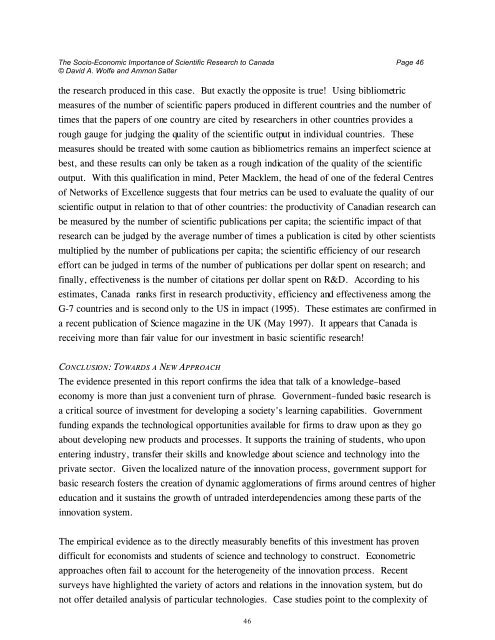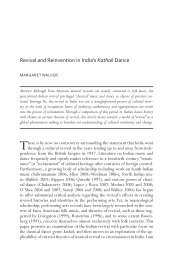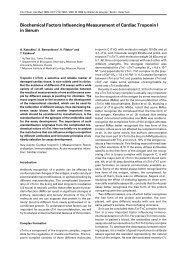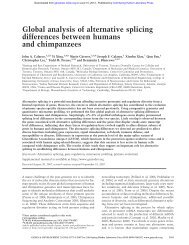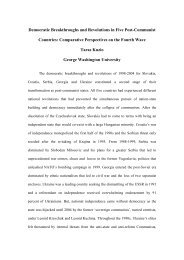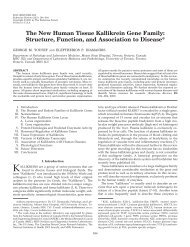The Socio-Economic Importance of Scientific Research To Canada
The Socio-Economic Importance of Scientific Research To Canada
The Socio-Economic Importance of Scientific Research To Canada
Create successful ePaper yourself
Turn your PDF publications into a flip-book with our unique Google optimized e-Paper software.
<strong>The</strong> <strong>Socio</strong>-<strong>Economic</strong> <strong>Importance</strong> <strong>of</strong> <strong>Scientific</strong> <strong>Research</strong> to <strong>Canada</strong> Page 46© David A. Wolfe and Ammon Salterthe research produced in this case. But exactly the opposite is true! Using bibliometricmeasures <strong>of</strong> the number <strong>of</strong> scientific papers produced in different countries and the number <strong>of</strong>times that the papers <strong>of</strong> one country are cited by researchers in other countries provides arough gauge for judging the quality <strong>of</strong> the scientific output in individual countries. <strong>The</strong>semeasures should be treated with some caution as bibliometrics remains an imperfect science atbest, and these results can only be taken as a rough indication <strong>of</strong> the quality <strong>of</strong> the scientificoutput. With this qualification in mind, Peter Macklem, the head <strong>of</strong> one <strong>of</strong> the federal Centres<strong>of</strong> Networks <strong>of</strong> Excellence suggests that four metrics can be used to evaluate the quality <strong>of</strong> ourscientific output in relation to that <strong>of</strong> other countries: the productivity <strong>of</strong> Canadian research canbe measured by the number <strong>of</strong> scientific publications per capita; the scientific impact <strong>of</strong> thatresearch can be judged by the average number <strong>of</strong> times a publication is cited by other scientistsmultiplied by the number <strong>of</strong> publications per capita; the scientific efficiency <strong>of</strong> our researcheffort can be judged in terms <strong>of</strong> the number <strong>of</strong> publications per dollar spent on research; andfinally, effectiveness is the number <strong>of</strong> citations per dollar spent on R&D. According to hisestimates, <strong>Canada</strong> ranks first in research productivity, efficiency and effectiveness among theG-7 countries and is second only to the US in impact (1995). <strong>The</strong>se estimates are confirmed ina recent publication <strong>of</strong> Science magazine in the UK (May 1997). It appears that <strong>Canada</strong> isreceiving more than fair value for our investment in basic scientific research!CONCLUSION: TOWARDS A NEW APPROACH<strong>The</strong> evidence presented in this report confirms the idea that talk <strong>of</strong> a knowledge–basedeconomy is more than just a convenient turn <strong>of</strong> phrase. Government–funded basic research isa critical source <strong>of</strong> investment for developing a society's learning capabilities. Governmentfunding expands the technological opportunities available for firms to draw upon as they goabout developing new products and processes. It supports the training <strong>of</strong> students, who uponentering industry, transfer their skills and knowledge about science and technology into theprivate sector. Given the localized nature <strong>of</strong> the innovation process, government support forbasic research fosters the creation <strong>of</strong> dynamic agglomerations <strong>of</strong> firms around centres <strong>of</strong> highereducation and it sustains the growth <strong>of</strong> untraded interdependencies among these parts <strong>of</strong> theinnovation system.<strong>The</strong> empirical evidence as to the directly measurably benefits <strong>of</strong> this investment has provendifficult for economists and students <strong>of</strong> science and technology to construct. Econometricapproaches <strong>of</strong>ten fail to account for the heterogeneity <strong>of</strong> the innovation process. Recentsurveys have highlighted the variety <strong>of</strong> actors and relations in the innovation system, but donot <strong>of</strong>fer detailed analysis <strong>of</strong> particular technologies. Case studies point to the complexity <strong>of</strong>46


